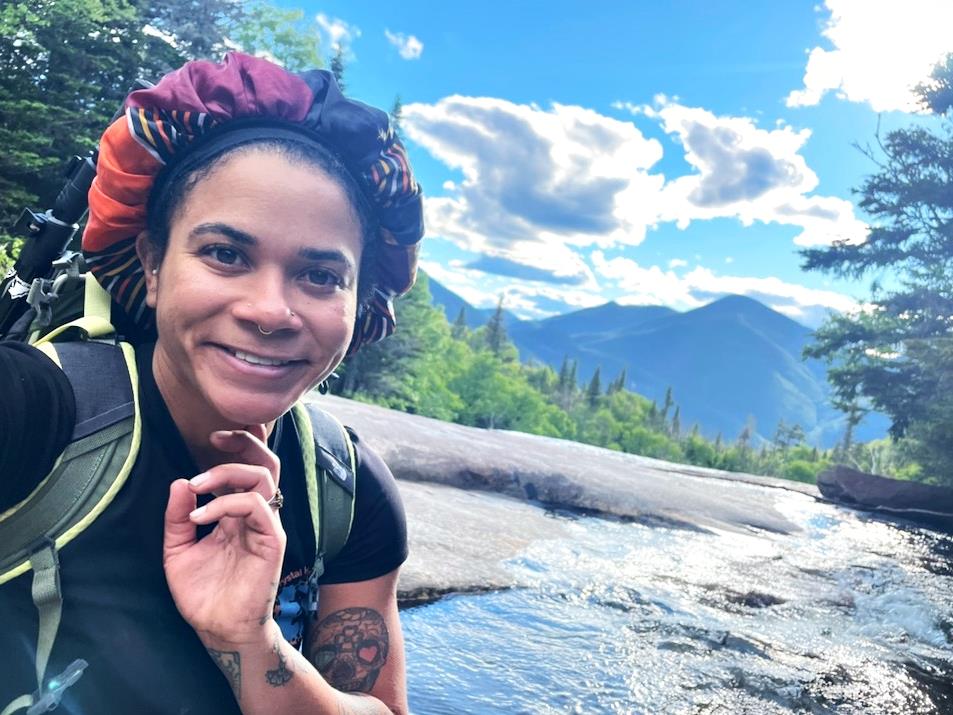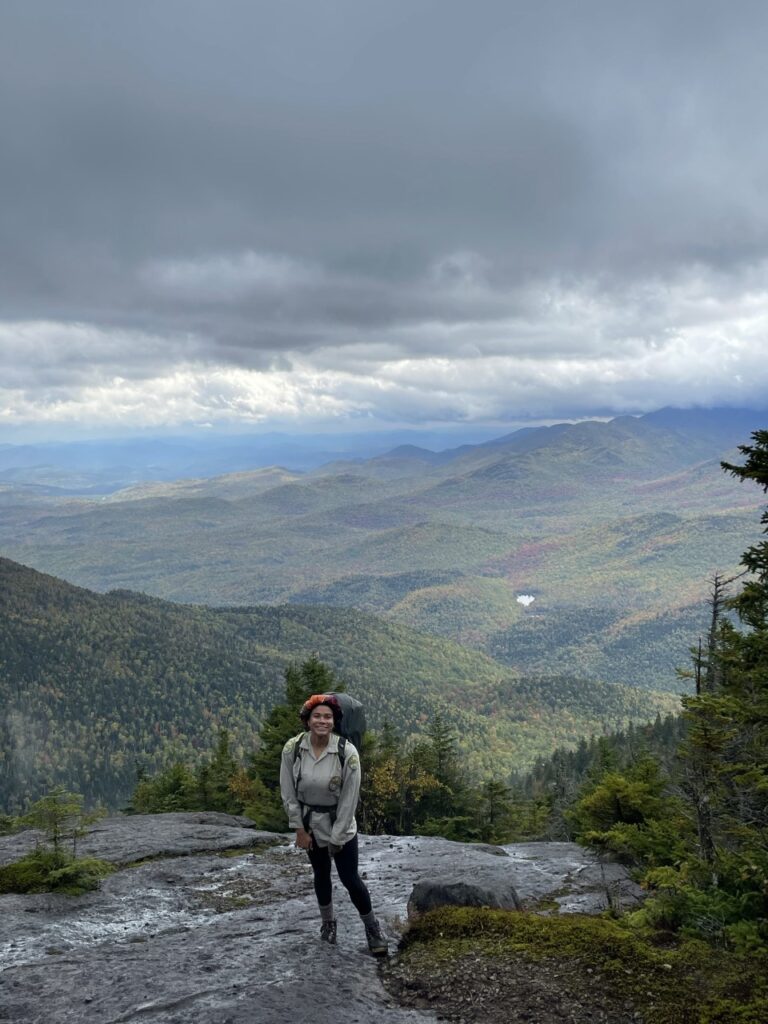The First Black Summit Steward and the Journey to Representation
The First Black Summit Steward and the Journey to Representation
By Klarisse Torriente
It was the day before Father’s Day when I asked my dad to meet me at the trailhead of Wyndham Peak in the Catskills. We were slated to do our first hike together since we attempted when I was 8, and failed miserably. Of course I picked a high peak, not in the Adirondacks, but in the Catskills. At this point in time, I had been spending the greater part of the last two years going on many challenging hikes alone. Trying to learn more about the land that I loved and cared about so much, while also spending contemplative time attempting to learn about myself. When I talk about my hikes with people near and dear to me, especially my family, I am often met with pleas of caution, care, and intense confusion; because for them walking in the woods is taboo or a threat. For me, it is comfort; there’s a symbiotic relationship with the forest and me. I made a promise to take care of it, in response to all the care that it has given me.
After years of hiking and sending my dad pictures, or Facetiming him from icy peaks, he asked to share a trek. So naturally I thought Father’s Day would be a perfect excuse. We met at the trailhead, bug sprayed every inch of our lives, and headed in. We weren’t even a mile in before my dad started to get jumpy and freaked out by every twig break. After witnessing a few near heart-attacks over chipmunks, I took a deep breath and said, “you know, I feel the safest here compared to anywhere else in the world.” The man stopped in his tracks, turned to me with his quintessential, “really, Klarisse?” I simply replied, “without a doubt”, and started to explain how this sense of security felt from within. You see, my dad is a Black man of Cuban descent born in 1963 in the South Bronx. He spent most of his life breathing city air, unlike his first daughter who prefers the mountains over any concrete jungle.

We headed up the meandering switchbacks as we ascended. I stopped multiple times to take out my film camera to document the momentous point in our history—student now teaching the teacher. I was able to share with him the names of different trees, invasive plants, and singing birds. I was able to share the history of how the Catskills formed, how there was a rich river delta that left behind sediments. I could hear and feel his anxieties decrease as we spent more time walking, learning, becoming more acclimated. Then we hit the summit, and all the fears escaped him as he became engulfed by the view.
Throughout the course of my life, I have had the pleasure of watching my father’s relationship with the land change. From running over the Newburgh-Beacon bridge, taking in the landscape, to volunteering to hike with me to learn more. Since I grew up close to green spaces, and had opportunities to explore and learn freely, I have been able to share my knowledge and privilege with my father. He moved upstate out of the New York City, but his whole work-life experience was pretty hyper-focused on that environment. It has been through time spent in solidarity with his children that he has been able to acclimate and explore new environments that were once foreign to him. His experience is not an anomaly, but fairly typical for Black humans in the United States.

There are stereotypes about people of color, specifically Black people, and their relationship with outdoor recreation. There are also a lot of feelings of fear among many Black people about being alone in nature and water that date back to slavery, Jim Crow, and the years of lynching in this country. Furthermore outdoor recreation can be segregating for a variety of reasons. In order to access some of New York’s most beautiful and expansive protected lands, you have to have access to a car. To go camping, backpacking, participate in water or winter sports, you need the appropriate gear to support such ventures—which are expensive. People like my dad, growing up in a two bedroom apartment with six people did not have the luxury to pack up the minivan and head into the Catskills for a hike. They did not have friends or family who related to the land in that way either. His parents migrated from Cuba where the ecosystems differ greatly from New York State. Their echo chamber in regards to outdoor recreation was limited to Bear Mountain and Orchard Beach. It was not until my dad had two children in elementary school in Newburgh, New York, who were curious and had peers with access to the outdoor resources, that we began to haphazardly attempt to explore nearby trails. I remember our first “hike” as kids vividly. We got lost at Storm King Mountain for less than an hour. Once we found our bearings, dad ended our hike promptly and I did not hike again until I was on my high school’s Cross Country team six to seven years later.
People of color, I believe, have systematically been marginalized from outdoor recreation for decades via the urbanization of humans post-Great Migration, redlining, Muir’s racist beliefs regarding the indigenous and other people of color, Frederick Law Olmsted’s involvement in the destruction of Seneca Village, a Black middle class NYC community, to create Central Park and people of color being treated as if their presence in nature is misplaced. Incredibly unjust recent examples would be the Black bird watcher, Christian Cooper in NYC who got the NYPD called on him by the now infamous Amy Cooper (no relation to Christian Cooper), and the Black jogger, Ahmaud Arbery, who got shot in Georgia by Gregory McMichael and his son Travis McMichael for simply enjoying the same outdoor recreation that white people partake in freely with no fear.
When I first started hiking in high school and after college, 2007-2014, I most often than not, unless I brought a friend, was the only person of color I saw, let alone the only Black human on the trails. Thankfully, times are changing and I am seeing more human diversity out in the woods. Lately, due to groups like Outdoor Afro and the nation’s reckoning with racial inequality, there have been more opportunities for people of color to engage with the natural world with care and community. I have joyously seen an uptick in people who look like me on the trails, but we still have a lot of work to do to promote equitable access.

I truly believe in order to conserve and protect our land we need to promote opportunities for all of New York’s residents to have a relationship with nature. If you do not understand or fear something, how are you supposed to have the will and wherewithal to protect it? I became a volunteer Summit Steward because I wanted to increase representation in the program. Prior to being a Summit Steward I had never encountered a Black Ranger, Steward, or Environmental Educator in my life, nor in the Adirondacks or Catskills. That is not to say they do not or did not exist, just their lack of prevalence was noticeable.

Becoming a Steward has been one of the most rewarding experiences I have had in nature. The educational component to the program is prolific, we are teaching hikers how to identify and protect alpine vegetation that has been around since the glaciers—a truly living natural history museum. We are also teaching folks safe hiking and camping practices in effort to mitigate harm and create more symbiosis between humans and the land. In order to be a Summit Steward, you participate in a comprehensive educational training program predominantly focused on educating about alpine conservation, and how to engage with the masses. I have found this experience to be invaluable. The people I have met and the lessons I have learned have me craving for more, even though I have been met with mixed regard on the trails and on the summit.
As aforementioned, I spend a lot of time hiking alone, and have often been met with varied emotions from fellow hikers, especially in the Adirondacks. Don’t get me wrong, a majority of people are super friendly and engaging. But, I have had a fair share of folks assume I do not belong where I am, or start speaking loudly about their negative sentiments towards Critical Race Theory/BIPOC folks in general, or my least favorite, suggest I abort the hike, assuming I cannot handle it. These negative experiences are what further marginalize BIPOC folks from hiking or becoming Summit Stewards themselves. Due to these negative experiences, I felt empowered to make myself more visible by becoming a Summit Steward, and I believe there are ways to even further increase diversity within the program. One way would be to provide housing to traveling Stewards, or discounts to local mountaineering shops, or local eateries to defray some of the expenses associated with venturing to places outside of someone’s natural community.
I want to educate more folks around why and how BIPOC communities have been marginalized from outdoor recreation. I believe if we understand the problem then we are well prepared to mitigate the potential negative impacts. I do not want to be the only one—this story is not just about me. It will take a community of humans, white and BIPOC, in order to change the way we all interact and protect our environment. Representation matters in this world to children and adults. People have increased capacity to learn when they can see themselves in the materials, or to be taught in a way that is relevant to their lives. I want more people of color to see themselves as natural resource Stewards, whether it be on the trail, or oceanside. I want more people of color to see someone that looks like them outside, educating the masses, so that they feel welcomed and empowered to do the same.
Klarisse currently serves as a researcher for SUNY System Administration’s Prison Education team and the Diversion Manager at Joseph’s House and Shetler, Troy. She is an avid believer in the dignity of all human beings and is a fervent advocate for prison reform, homelessness mitigation and prevention, access to mental health services, and most fervently creating more opportunities for BIPOC folks to have a substantive relationship with nature and the land around them. She has over ten years’ experience in human services, advocacy, and community organizing. Klarisse also was a policy fellow for the Center for Women in Government through Rockefeller College where she served as a policy analyst, developing an extensive knowledge for New York State Government and the legislative process. Klarisse earned her Bachelors of Science in Forensic Sociology from Rosemont College and her Master of Social Work from the State University of New York at Albany. You can catch her on a mountain, roller rink, or skate park nearest you!
Related
ADK Rebuilds Vandalized Wright Peak Cairns
On September 15, 2025, nearly every rock cairn above treeline on Wright Peak was destroyed. […]
The Summit Stewardship Program: Leading the Way in Visitor Use Management
In the 1990s, the summit stewards working on Mount Marcy had a problem. The Summit […]
Summit Stewards Reflect on 2023 Season
November 6, 2023 — Lake Placid, NY — In its end of season report, the […]
Extirpated Alpine Plant Discovered on Algonquin
August 29, 2023 — Lake Placid, NY — The Adirondack High Peaks Summit Stewardship Program […]

